中国组织工程研究 ›› 2019, Vol. 23 ›› Issue (9): 1342-1348.doi: 10.3969/j.issn.2095-4344.1623
• 肿瘤干细胞 cancer stem cells • 上一篇 下一篇
RNA干扰Id2基因表达抑制PC-3前列腺肿瘤干细胞的增殖及侵袭能力
张莹莹1,王英磊2,孟 琳2,肖 琳2,李忠海2,赵战魁2,吴厚苛2
- 济宁医学院附属医院,1儿科,2泌尿外科,山东省济宁市 272000
RNA interferes with Id2 gene expression to inhibit proliferation and invasion of PC-3 prostate cancer stem cells
Zhang Yingying1, Wang Yinglei2, Meng Lin2, Xiao Lin2, Li Zhonghai2, Zhao Zhankui2, Wu Houke2
- 1Department of Pediatrics, 2Department of Urology, Affiliated Hospital of Jining Medical University, Jining 272000, Shandong Province, China
摘要:
文章快速阅读:
.jpg)
文题释义: 上皮-间质转化:指上皮细胞到间质细胞的转化,它赋予细胞转移和入侵的能力,不仅在发育过程中起着关键的作用,而且还参与组织愈合、器官纤维化和癌症发生等过程。 Id因子:是Perk等于1990年首先从鼠红白血病细胞cDNA文库中克隆出来的蛋白质,因其能抑制转录因子与DNA结合,又称为DNA结合抑制因子,属于碱性螺旋-环-螺旋(bHLH)转录因子家族,其中最受关注、作用最广泛的是Id2和Id3因子。
摘要
背景:Id基因是碱性螺旋-环-螺旋因子的内源性负性调节因子。该因子参与细胞的增殖、分化和生存,并在不同类型肿瘤的进展和浸润过程中表现出功能的多样性。
目的:探讨沉默Id2基因表达对人前列腺肿瘤干细胞增殖和侵袭能力的影响。
方法:取对数生长期的PC-3人前列腺癌细胞,采用无血清悬浮培养法分离肿瘤干细胞球,流式细胞仪检测肿瘤干细胞表面标记CD44+CD24-表达。构建shRNA-Id2表达载体,转染至前列腺肿瘤干细胞,以未转染的前列腺肿瘤干细胞为对照。转染后48 h,采用RT-PCR与Western blot实验检测前列腺肿瘤干细胞Id2基因及蛋白的表达;采用MTT法、Transwell小室检测前列腺肿瘤干细胞的增殖和侵袭能力;采用Western blot与RT-PCR检测前列腺肿瘤干细胞上皮标志物E-钙黏蛋白、间质细胞标志物波形蛋白及上皮细胞-间充质转化调控转录因子Twist的表达。
结果与结论:①采用无血清悬浮培养法成功分离出肿瘤干细胞球,第3代前列腺肿瘤干细胞表面标记CD44+CD24-表达率为(85.69±8.96)%,显示培养的肿瘤干细胞球高表达肿瘤干细胞表型;②转染后48 h,shRNA-Id2转染组细胞Id2基因及蛋白表达明显低于未转染组(P < 0.05),显示成功干扰了前列腺肿瘤干细胞Id2表达;③shRNA-Id2转染组前列腺肿瘤干细胞的增殖速度和侵袭能力低于未转染组(P < 0.05);④shRNA-Id2转染组前列腺肿瘤干细胞的上皮标志物E-钙黏蛋白表达高于未转染组(P < 0.05),间质细胞标志物波形蛋白、上皮细胞-间充质转化调控转录因子Twist表达低于未转染组(P < 0.05);⑤结果表明,RNA干扰Id2基因表达可通过调控E-钙黏蛋白、波形蛋白及Twist表达抑制前列腺肿瘤干细胞的增殖及侵袭能力。
中国组织工程研究杂志出版内容重点:干细胞;骨髓干细胞;造血干细胞;脂肪干细胞;肿瘤干细胞;胚胎干细胞;脐带脐血干细胞;干细胞诱导;干细胞分化;组织工程
ORCID: 0000-0003-1498-439X(张莹莹)
中图分类号:
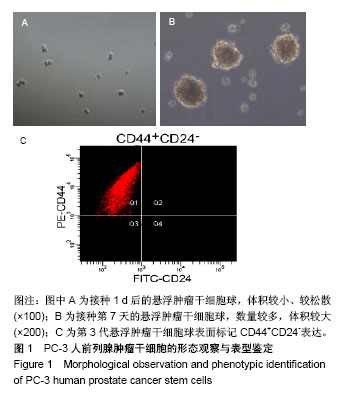
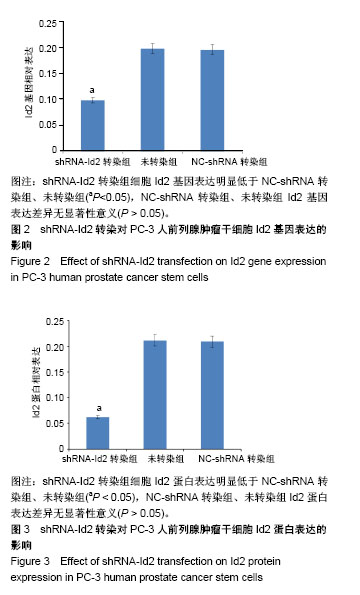
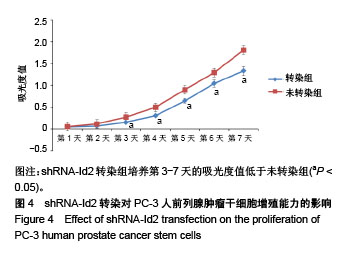
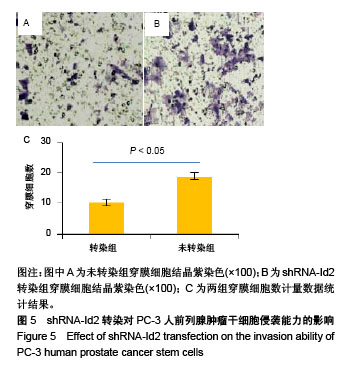
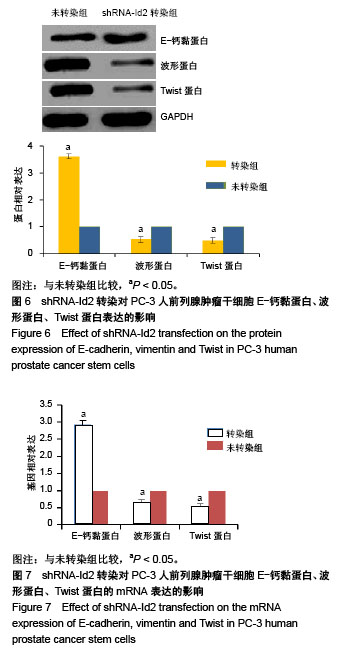
.jpg)
.jpg)